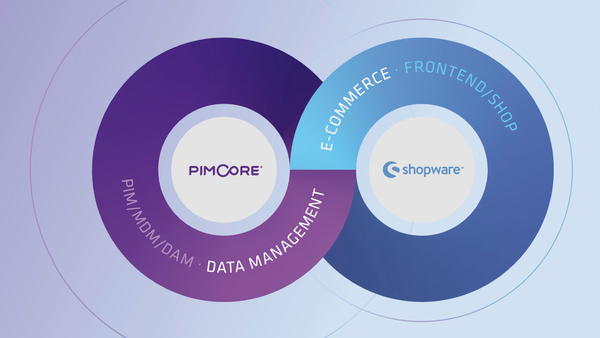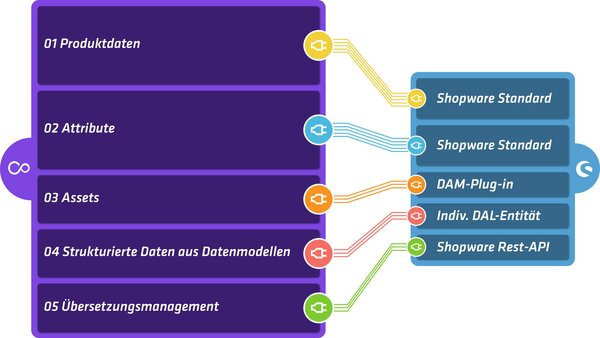Connect Pimcore & Shopware: Secure and Fast
Pimcore and Shopware are among the leading systems in their fields - Pimcore in the area of data management, Shopware in the area of e-commerce. These two systems are also closely related in technical terms. What could be more obvious than combining the two systems to create a perfect symbiosis?

Pimcore
Pimcore is one of the most widely used and best data management systems currently on the market. The system is modular, the Pimcore family is home to an excellent PIM/MDM system for the management of structured data far beyond pure product data. In addition, the seamless Pimcore DAM system manages images, videos, PDFs, i.e., all assets that are created and used in companies. At the same time, Pimcore is better than almost any other system at linking data with each other and at the same time offers the prerequisites for smoothly transferring this data to a wide variety of locations. Anyone who has already worked with Pimcore appreciates the system's high degree of flexibility and customizability, which enables the development of tailor-made solutions for almost any use case. The framework is based on the latest technology and offers many clever out-of-the-box functions, particularly in the area of data models. Pimcore is headless and works reliably in many applications in the hidden management of data and as a data provider for a wide variety of target channels.
Shopware
Shopware is a comprehensive store solution for B2C and B2B requirements and offers a sophisticated out-of-the-box store. Unlike the Digital Commerce Framework from Pimcore, Shopware is largely prefabricated and can therefore be used quickly. Shopware impresses with a wealth of high-quality key features that make it easy to get started in the world of e-commerce, but which can also be used to create large, international stores. In addition, Shopware continuously optimizes its platform to meet the needs of customers throughout the entire purchasing process - guaranteeing a good customer experience right through to the completion of the purchase. And Shopware has an extensive ecosystem with many plugins
that offers a wide range of additional functions.
Link Pimcore & Shopware individually?
Why linking Pimcore and Shopware individually is not a good idea:
The temptation is great to connect Pimcore and Shopware statically, field by field, if necessary. In the long term, however, this approach falls short. Customer-specific programming only ever covers the associated requirements. Why should more be done, because the additional work for future functions usually does not cover a budget. An agile way of working also sometimes favors planning for the long term and only solving the task at hand. This means a fresh start for every project.
Copying solutions from existing projects is also not a recommendation.
Copying development solutions from existing projects reduces the workload and is therefore often done, unfortunately, with the risk of copying errors. As a result, every error must be corrected in all projects where the copied solution is used. Individual, customer-specific programming also increases the effort required for clean, complete documentation. The documentation must also be adapted or extended for each adaptation or extension. However, the premature end to this way of working comes with every system update of Pimcore and Shopware. Each release of both systems requires a check to ensure that the adaptations and extensions continue to work as planned. This supposedly simpler approach turns into a time and cost trap.
The result: updates are avoided for cost reasons and the solution becomes obsolete immediately after implementation.
Why a generic approach to the Pimcore Shopware connection is simply better
The basic idea behind the generic approach is based on a broad catalog of requirements. This approach is not based on a specific customer requirement but on the need to find a general and flexible solution that can be adapted to the customer's needs with little effort. The solution is to be implemented via a central package management system with a Pimcore bundle and Shopware plug-in. The advantages of this type of implementation are
- easier adaptation of new project requirements
- centralized and, therefore, unique error correction
- easy updatability
In addition, this solution benefits from further future developments - new extensions can be adopted more easily and in a more controlled manner.
From the idea to implementation

Data management in Pimcore includes the management of product data, attributes, assets, structured data and translations. The Shopware standard has the appropriate counterparts for this division. A total of five connectors were designed and developed for the smooth exchange of all relevant data from Pimcore to Shopware. On the Pimcore side, the integration of the connectors is realized via a package bundle, on the Shopware side via a plug-in. With software releases of Pimcore or Shopware, a check and, if necessary, an update of the connectors takes place at twocream, which is made available for all applications. With software releases of Pimcore or Shopware, a check and, if necessary, an update of the connectors takes place at twocream, which is made available for all applications. For a seamless connection between Pimcore and Shopware, each connector adapts to the requirements. Some connectors communicate via exchange directories and others directly via an API integration.
Five different Pimcore/Shopware connectors
01 Product connector
The product connector imports the project-specific Pimcore product data into the Shopware standard. Depending on the type of product data, the data is imported into the Shopware catalog under Products or assigned to a category or sales
channel. This includes:
- Texts, general information such as product descriptions or benefit arguments
- General properties such as typical product characteristics
- SEO information
- Prices, if the prices are not delivered directly from the ERP to the store
- Delivery information, unless the delivery information is also supplied directly by the ERP
- Variants of main products
- Cross-selling products that are managed as such in Pimcore
- The assignment of sales channels and categories
- The assignment of images from the Pimcore DAM system
02 Attributes connector
The attribute connector recruits the project-specific Pimcore product attributes such as color, weight, etc.. This information is essential for filtering in Shopware The attributes are delivered to the Shopware catalog as Shopware product properties. This includes:
- Recruitment of attributes from product objects and object bricks
- Filter option for field types in the product class
- Filter option for field types in the object bricks
- Block and allow list for field identifiers
- Derive dedicated objects for each product property
- Derive dedicated objects per product property value
- Control of Shopware-specic settings in Pimcore
- Management of the attribute labels
- Delivery to the Shopware standard as product properties
03 MDM connector
In Pimcore, individually structured data such as reference objects, press releases, FAQs, downloads, contacts, etc. can be managed. The MDM connector imports these individual data models as Shopware DAL entities. The DAL entities are displayed in a structured manner in the Shopware front-end. This includes:
- Central management of the source images in Pimcore
- Management of the various page formats and resolution derivatives
- Playout to Shopware via the Pimcore media library
04 DAM connector
DAM management takes place in Pimcore for easy use in the Shopware experience worlds. The source images are managed in the Pimcore DAM system for this purpose. Responsive design requires various page formats and resolution derivatives, which Pimcore creates automatically. The finished images are played out in all required data via the Pimcore media library into the Shopware media library. This includes:
- MDM data models for individual structured data are managed in Pimcore, such as reference objects, press releases, FAQs, downloads, contacts, etc
- MDM data models are exported to Shopware as DAL entities
- Individual DAL entities are displayed in a structured form in the Shopware front-end
05 Across Connector
The Across connector enables automated translation management with Pimcore/Shopware and Across. To this end, Across was seamlessly integrated into Pimcore via the Pimcore Across Cockpit. The Shopware worlds of experience were also integrated into the translation process. The translation workflow also includes an optional automated translation via Deepl. Terminology and translation memory guarantee a high and customer-specific translation quality. This includes:
- Seamless integration of Across
- End-to-end translation workflows with optional automated translation
- High-quality translations supported by terminology and translation memory
Conclusion
The connectors enable a more professional and faster interaction between Pimcore and Shopware. In addition to the basic connectivity between the two systems, automation increases the overall process quality and update capability.
